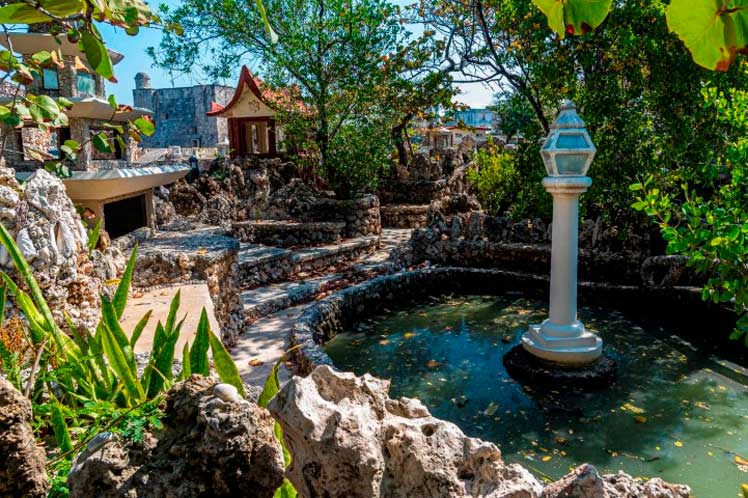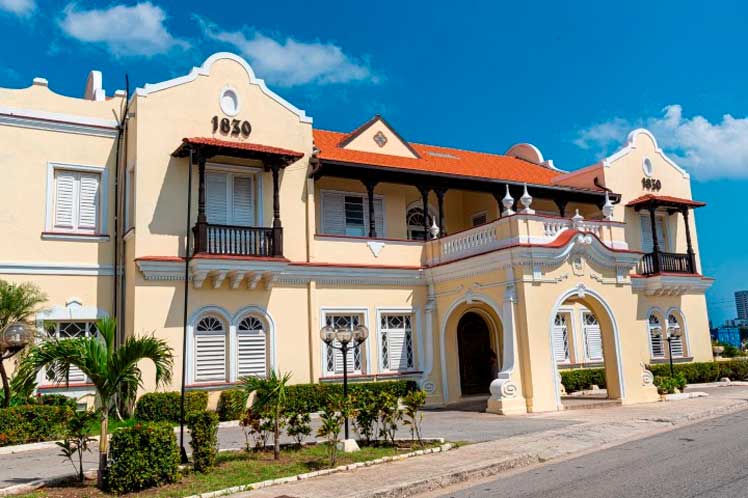At the origin of this late 19th-century building is the Arana house, a restaurant much visited by the wealthy families of the time and some high-ranking Spanish officials, who enjoyed the bacalao a la Vizcaína (Cod fish Vizcaíno style) and the famous arroz con pollo a la Chorrera (a very moist chicken and rice), named after the colonial tower that stands almost next to it.
With a privileged location at the western end of Havana’s Malecón, right at the mouth of the Almendares River, after several works, the building was leased by Carlos Miguel de Céspedes, who was Secretary of Public Works during the first government of Gerardo Machado (1925-1929) and one of his closest collaborators.
After turning it into his residence under the name of Villa Miramar, the Cuban politician —a descendant of the Father of the Homeland, Carlos Manuel de Céspedes— expanded the facility by building a pier, gardens, the mosque and the monkey island, known as the Japanese island, Inty José Álvarez, the institution’s manager, told Prisma.
After the fall of Machado;s regime in August 1933, both De Céspedes and his family managed to escape the popular wrath, while the house was looted and practically destroyed. It would not be until his return, under an amnesty, that he would be able to rebuild it.
He died here in 1955, and then the property was acquired by the Currais family, who turned it into a hostel and restaurant with the name 1830, in allusion to the year in which they had founded another enterprise of their property, the no less known: La Zaragozana, added Álvarez.

Varied offerings and cultural life
The “1830” preserves the aristocratic splendour that distinguishes the mansion, with its large windows, stained glass, railings and precious wood, treasuring original pieces such as the lamp, the mirror, the objects that rest in the niches, the guineas, the console, the sconces and some that have patrimonial character,
such as the pheasants, the biscuit and the sighs, said its manager.
With capacity for 200 diners, the site —which maintains among the offers the traditional chicken and rice a la Chorrera— has the Gold, Tropical, Red, Violet rooms, as well as the Colonial bar, located in the old library. Upstairs are the Green, Blue and Imperial rooms, each with a capacity for eight people.
According to the manager, on the occasion of Havana’s 500th anniversary, an annex was inaugurated to house a tapas and wine bar, where activities such as Wine Friday, Sparkling Wine and Sommelier Women’s Day are held. We also have the Karaoke bar, the Dos Aguas cafeteria and, with a more informal service, La Chorrera.
In the outdoor areas, where there are other offers of food and services for weddings and 15th birthdays (quinces), the dancing Casino Round project has been carried out for more than 16 years, said Amado Amaya, head of the 1830 gardens party room.
With this motivation, the restaurant receives not only those who bet on traditional gastronomy, but also foreigners interested in knowing the Cuban culture and learning to dance.
Before the Covid-19 pandemic, several events were held: on Tuesdays, Rumba Day; on Thursdays, Founders’ Day, as a tribute to the pioneers of casino dancing; on Saturdays, young talents performed; and on Sundays, the Moncada group offered concerts.
Prisma learned that these activities and others associated with PMM’s
audiovisual project, which brought to this stage orchestras such as Los Van Van, Elito Revé and its Charangón, Manolito Simonet and his Trabuco, among others, are expected to resume soon.
After a long wait as a result of the pandemic, Havana’s cultural and gastronomic life is renewed with magical corners such as those offered by the historic 1830 restaurant. (Published in Prisma)










